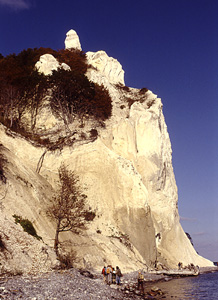 Folds in mountain systems
Folds in mountain systems

| Mt. Kidd, Kananaskis Mountains, Alberta, Canada. Overview (left) and close-up shot (right). Thick Mesozoic carbontate strata are tightly folded in the Canadian Rockies front range. The strata were deformed by "thin-skinned" thrusting over a décollement in underlying rocks.
|  |

| Large overturned, tight fold of Mesozoic carbonate strata in the Helvetic Alps. Lütschental, central Switzerland. Overview (left) and close-up shot (right). Kink bands appear on both limbs of the fold, and the fold axis is clearly visible.
|  |

| Complex folding of incompetent strata in the Ouachita Mountains. Overview (left) and close-up shot (right) of convoluted folding in the Big Fork Chert (Ordovician), Hot Springs, Arkansas.
|  |

| Recumbent, tight to isoclinal folds. Overview to left, and closer shot of Kirkeporten (the church door) on right. Metamorphic strata in the Caledonian mountain system of Silurian age. Skarsvåg on the island of Magerøya, northernmost Norway.
|  |

| Folds in the Manhattan Schist, Central Park, New York City. Tight folds with small crenulations (left). Surface displays glacial grooves. Strong shearing (right) leads to highly stretched folds and foliated banding.
|  |

| Appalachian Piedmont metamorphic strata, Lake Murray spillway, South Carolina. Folded dike in schist (left). Knitting needle marks fold axis. Folded dike in schist (right). Dike is broken by quartz veins filling gash (tension) fractures. Scale is 6 inches (15 cm) long.
|  |

| Intricately folded gneiss in the Caledonian mountain system (mid-Paleozoic). Note variation in fold size and style from layer to layer. Silva compass for scale. Island of Herdla, western Norway.
|  |

| Complex folding of Caledonian (mid-Paleozoic) amphibolite (left). Note the irregular thickening, thinning, and disruption of the white layers within the darker mass. Scale pole is 2 m long. Haugesund, southwestern Norway. Huge boudins (right) formed by intensive folding and stretching of the rock mass. Paleozoic schist, near Mérida, Andes Mountains, Venezuela
| 
|

| Extremely stretched folds and foliation (left). Notice the "hook" structure (just below sunglasses); this is all that remains of a strongly sheared fold. Hudson Highlands, eastern New York. Tight, recumbent fold (right) with numerous smaller kink folds on its limbs. Field of view about 1 m across. Near Kirkeporten, Skarsvåg, on the island of Magerøya, northernmost Norway.
| 
|

| Isoclinal, recumbent fold in glacial sand, clay, and till. Overview (left) and detail (right). Scale pole marked in 20-cm stripes. Pen marks the horizontal fold axis. Island of Møn, southeastern Denmark.
|  |

| Isoclinal folding (left) and chalk-banded till (right) involve chalk, till, and sand strongly sheared and deformed into chalk-till mélange. Island of Møn, southeastern Denmark.
|  |

| Complexly folded chalk-till mélange includes chalk, till, and sand. Overview (left) and detain of overturned fold (right). Scale pole marked in 20-cm stripes. Hvideklint, Møn, southeastern Denmark.
|  |



 Return to Table of Contents.
Return to Table of Contents. 


 Return to Table of Contents.
Return to Table of Contents.